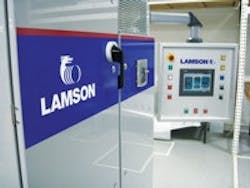About the author: Todd Nelson is territory sales manager for Hoffman & Lamson, Gardner Denver Products. Nelson can be reached at [email protected] or 801.732.0897.
Over the past decade, the cost of energy has risen at an alarming pace. It has become imperative that corporations and municipalities find ways to cut energy consumption. In wastewater treatment plants, the largest consumers of energy are blowers and pumps. Historically, the blowers have been of the multi-stage, constant-speed design. At its design point, a constant-speed machine is very efficient; however, at some point, the blowers run at a speed other than its full load or design point.
The air flow and/or pressure can vary during operation due to changes in demand, such as the quality or quantity of wastewater or an inlet temperature change as day goes into night and summer into winter. This necessitates a way to adjust the blowers, or “turn them down” to less than full load. The traditional way to adjust a blower is to use an inlet butterfly valve, which alters the system resistance curve in order to adjust and control the pressure and flow. This inlet throttling process is simple to use but not energy-efficient.
Variable-Frequency Drive
There is another way to accomplish the same effect: Use a variable-frequency drive (VFD) connected to a direct-drive multi-stage centrifugal blower. In such a blower, the VFD serves as a speed adjusting device to maximize its efficiency. For an existing wastewater treatment plant installation, retrofitting a VFD requires minimum investment and lead time while achieving drastic energy savings.
In a typical installation, a traditional motor starter is replaced with a VFD drive, which also is capable of soft starting. New controls are installed to prevent surges and provide an input mechanism for blower adjustment. The most common variations are flow and pressure. The required blower flow rate is proportional to the biochemical oxygen demand, which is proportional to the quantity and quality of the water. Deeper tanks or inlet temperature changes also cause pressure demand variation.
Precise process control can be achieved with a VFD by linking a dissolved oxygen sensor to the blower’s VFD. This will maintain a predefined oxygen concentration over a wide range of water flow and biological loading conditions. It also can be managed through manual input: The operator inputs the desired flow and the controls calculate the needed speed.
By using VFDs, the speed range is wide and variable, typically from 0 to 120 Hz, which more than doubles the direct-drive speed of a multi-stage blower. How fast a motor and blower can run is only limited by mechanical criteria, such as bearings, lubrication, impeller and rotor strength, and the critical speed of the rotor assembly.
There also is a velocity limit for the air going through the inlet flange. Typically, a 20% speed increase is readily available for most 60-Hz blowers. As for sizing, instead of running all blowers at a nominal 3,600 rpm, each blower will have its own maximum speed, optimized for its mechanical design and performance. The goal is to maximize the mechanical design potential of every blower frame to reach the best performance with the least number of stages (minimum blower size).
More VFD Benefits
There are other benefits to using a VFD. The reduced speed offers a lower discharge temperature and lower vibration and noise levels, which are beneficial for both the blower and its surroundings. Due to the speed reduction, however, there is less pressure rise to surge with the VFD method than with inlet throttling. To maximize the pressure rise to surge, backward curved impellers should be selected, which also offer higher efficiency.
A VFD multi-stage blower is capable of a soft start, where the motor comes up to speed slowly rather than abruptly. This lessens the mechanical and electrical stress on both the blower and the motor, especially for applications with frequent starts and stops. This, in turn, reduces maintenance and repair costs and extends the life of the machinery.
By reducing the blower and motor speed when the demand is low, noise is greatly reduced. The absence of a partly closed butterfly valve further reduces noise. At the same time, the mechanical stresses on drive system are reduced and the temperature of the blower is lower, reducing thermal stress. Due to the nature of the technology, however, VFDs produce harmonic distortions that adversely affect other electrical machinery nearby. By installing a harmonic filter, or an isolation transformer, this problem can be greatly reduced.
High-Speed, Single-Stage Blowers
Building on these benefits, a new technology has been introduced to the market: high-speed single-stage blowers with high-speed motors and VFD technology. They are equipped with either magnetic or air foil bearings and a 5-axis machined impeller that allow them to operate at speeds up to 60,000 rpm. Even at these high speeds, the noise level is low, usually under 76 dba. These machines are low maintenance because they do not need lubrication. The bearings allow for non-contacting operation and the impellers have a small rotating mass. The VFD allows for operations at varying flows and pressures—just like the multi-stage units equipped with VFDs.
There are advantages and disadvantages to each type of machine. As wastewater treatment plants have improved, they have installed modulating valves to supply the correct amount of air to each aeration basin. Because high-speed blowers have a smaller rotating mass, they are more susceptible to the opening and closing of the modulating valves. Quick operation of the valves can push these blowers into surge very quickly. The larger rotating mass in a multi-stage blower allows them to be more resistant to this problem. The final comparison is capital cost. The high-speed blowers are, on average, 40% more costly than multi-stage units.
When it comes to upgrading or retrofitting a wastewater treatment plant, multi-stage VFD blowers can improve operating cost through the reduction of energy used by the aeration system.
